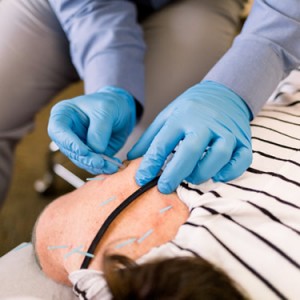Dry Needling in Sheridan
What Is Dry Needling?
 Dry Needling, a specialized myofascial trigger point therapy, is used for spasming and fatigued muscles, movement dysfunction, range of motion issues, and acute or chronic pain. (Myofascial trigger points are aching, throbbing, strained or knotted areas in the muscle tissues that often cause pain over a large region.)
Dry Needling, a specialized myofascial trigger point therapy, is used for spasming and fatigued muscles, movement dysfunction, range of motion issues, and acute or chronic pain. (Myofascial trigger points are aching, throbbing, strained or knotted areas in the muscle tissues that often cause pain over a large region.)
Who Can Benefit from Dry Needling?
Any patient that has pain and/or limited movement due to muscle pain can use dry needling therapy to reduce pain and increase function.
Dry needling is almost always a component of a more comprehensive pain management plan that may involve chiropractic, exercising, stretching or physical therapy. Some of the most common conditions that are treated with dry needling are:
- Headaches
- Migraines
- Radiculopathy (nerve pain)
- TMJ disorder
- Limited range of motion
- Neck pain
- Shoulder pain/impingement
- Tennis elbow
- Carpal tunnel syndrome
- Low back pain
- Hip pain
- Shin splints
- Knee pain
- Plantar fasciitis
Why Does Dry Needling Reduce Pain and Improve Movement Function?
When muscles are spasming or strained they develop trigger points that can cause pain and/or limited movement. The fibers in these “triggered” muscles are no longer getting the necessary amount of blood flow, nutrients and oxygen, that will allow the muscle to restore and relax to a normal balance. Due to the lack of normal blood supply at the trigger point, the muscle tissue is acidic the nerves are very sensitive, which causes pain and/or movement dysfunction.
These spasming muscles are restricted and stuck in a cycle, when a fine needle is inserted into the spasming trigger point, the muscle’s spasm cycle is interrupted, restoring normal blood and nutrient flow to the area, allowing the muscle to relax and heal. This process also stimulates the brain to release endorphins, and the parasympathetic nervous system to activate, which aids in full body relaxation and restoring the muscles and body to a more natural state of health.
What Happens During Dry Needling Treatments?
When you get a dry needling treatment, Dr. Winkelmann will palpate around the affected area to locate the trigger points in the region. Once the trigger points are located, he inserts thin needles into the trigger point tissues to disrupt the spasm. Patients may not even feel some needles that are used, and other trigger points will elicit a more noticeable “twitch” response, where the muscle is indicating an area with a very tight and inflamed trigger point.
What Should I Expect After My First Visit?
Some patients will feel relief almost immediately after a dry needling treatment, while other patients may need additional treatment sessions to experience the full benefits.
After dry needling, it is important that you heat the treated area and drink plenty of water, to ensure that your muscles stay hydrated. Some patients may get sore after the treatment. Soreness is expected as an inflammatory healing response. The soreness will go away as the muscles heal.
Is Dry Needling Therapy Right for You?
Talk to Dr. Winkelmann to see if dry needling would be a helpful component of your care. Dry Needling is an increasingly popular therapy used by athletes, the elderly, people with chronic pain and those suffering from injuries. Dr. Winkelmann has had success treating a myriad of conditions with dry needling, particularly when pairing needling with adjustments.
What Is the Difference Between Dry Needling and Acupuncture?
Acupuncture is based on Chinese Medicine and aims to balance the meridians in the body for the treatment of diseases. Dry needling is considered a modern (despite being used for several decades), science-based treatment focused on releasing trigger points and interrupting the painful muscle spasm cycles that occur.
Schedule Your First Visit Today
We accept new patients. Contact us today! We take insurance and are providers with TRICARE®, Blue Cross Blue Shield, Medicare and Medicaid.
CONTACT US »

